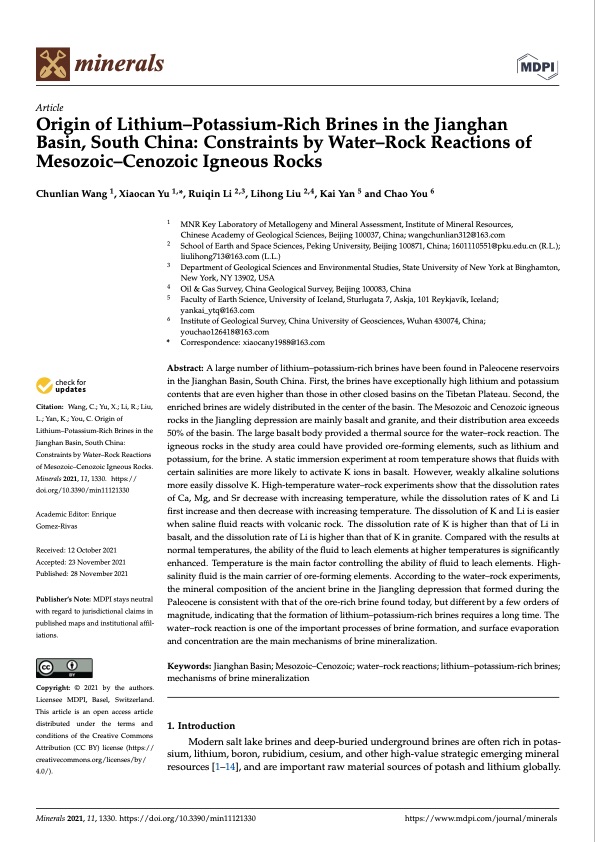
PDF Publication Title:
Text from PDF Page: 001
minerals Article Origin of Lithium–Potassium-Rich Brines in the Jianghan Basin, South China: Constraints by Water–Rock Reactions of Mesozoic–Cenozoic Igneous Rocks Chunlian Wang 1, Xiaocan Yu 1,*, Ruiqin Li 2,3, Lihong Liu 2,4, Kai Yan 5 and Chao You 6 Citation: Wang, C.; Yu, X.; Li, R.; Liu, L.; Yan, K.; You, C. Origin of Lithium–Potassium-Rich Brines in the Jianghan Basin, South China: Constraints by Water–Rock Reactions of Mesozoic–Cenozoic Igneous Rocks. Minerals2021,11,1330. https:// doi.org/10.3390/min11121330 Academic Editor: Enrique Gomez-Rivas Received: 12 October 2021 Accepted: 23 November 2021 Published: 28 November 2021 Publisher’s Note: MDPI stays neutral with regard to jurisdictional claims in published maps and institutional affil- iations. Copyright: © 2021 by the authors. Licensee MDPI, Basel, Switzerland. This article is an open access article distributed under the terms and conditions of the Creative Commons Attribution (CC BY) license (https:// creativecommons.org/licenses/by/ 4.0/). 1 2 3 4 5 6 * Correspondence: xiaocany1988@163.com Abstract: A large number of lithium–potassium-rich brines have been found in Paleocene reservoirs in the Jianghan Basin, South China. First, the brines have exceptionally high lithium and potassium contents that are even higher than those in other closed basins on the Tibetan Plateau. Second, the enriched brines are widely distributed in the center of the basin. The Mesozoic and Cenozoic igneous rocks in the Jiangling depression are mainly basalt and granite, and their distribution area exceeds 50% of the basin. The large basalt body provided a thermal source for the water–rock reaction. The igneous rocks in the study area could have provided ore-forming elements, such as lithium and potassium, for the brine. A static immersion experiment at room temperature shows that fluids with certain salinities are more likely to activate K ions in basalt. However, weakly alkaline solutions more easily dissolve K. High-temperature water–rock experiments show that the dissolution rates of Ca, Mg, and Sr decrease with increasing temperature, while the dissolution rates of K and Li first increase and then decrease with increasing temperature. The dissolution of K and Li is easier when saline fluid reacts with volcanic rock. The dissolution rate of K is higher than that of Li in basalt, and the dissolution rate of Li is higher than that of K in granite. Compared with the results at normal temperatures, the ability of the fluid to leach elements at higher temperatures is significantly enhanced. Temperature is the main factor controlling the ability of fluid to leach elements. High- salinity fluid is the main carrier of ore-forming elements. According to the water–rock experiments, the mineral composition of the ancient brine in the Jiangling depression that formed during the Paleocene is consistent with that of the ore-rich brine found today, but different by a few orders of magnitude, indicating that the formation of lithium–potassium-rich brines requires a long time. The water–rock reaction is one of the important processes of brine formation, and surface evaporation and concentration are the main mechanisms of brine mineralization. Keywords: Jianghan Basin; Mesozoic–Cenozoic; water–rock reactions; lithium–potassium-rich brines; mechanisms of brine mineralization 1. Introduction Modern salt lake brines and deep-buried underground brines are often rich in potas- sium, lithium, boron, rubidium, cesium, and other high-value strategic emerging mineral resources [1–14], and are important raw material sources of potash and lithium globally. MNR Key Laboratory of Metallogeny and Mineral Assessment, Institute of Mineral Resources, Chinese Academy of Geological Sciences, Beijing 100037, China; wangchunlian312@163.com School of Earth and Space Sciences, Peking University, Beijing 100871, China; 1601110551@pku.edu.cn (R.L.); liulihong713@163.com (L.L.) Department of Geological Sciences and Environmental Studies, State University of New York at Binghamton, New York, NY 13902, USA Oil & Gas Survey, China Geological Survey, Beijing 100083, China Faculty of Earth Science, University of Iceland, Sturlugata 7, Askja, 101 Reykjavík, Iceland; yankai_ytq@163.com Institute of Geological Survey, China University of Geosciences, Wuhan 430074, China; youchao126418@163.com Minerals 2021, 11, 1330. https://doi.org/10.3390/min11121330 https://www.mdpi.com/journal/mineralsPDF Image | Origin of Lithium Potassium Rich Brines in the Jianghan

PDF Search Title:
Origin of Lithium Potassium Rich Brines in the JianghanOriginal File Name Searched:
minerals-11-01330-v2.pdfDIY PDF Search: Google It | Yahoo | Bing
Product and Development Focus for Infinity Turbine
ORC Waste Heat Turbine and ORC System Build Plans: All turbine plans are $10,000 each. This allows you to build a system and then consider licensing for production after you have completed and tested a unit.Redox Flow Battery Technology: With the advent of the new USA tax credits for producing and selling batteries ($35/kW) we are focussing on a simple flow battery using shipping containers as the modular electrolyte storage units with tax credits up to $140,000 per system. Our main focus is on the salt battery. This battery can be used for both thermal and electrical storage applications. We call it the Cogeneration Battery or Cogen Battery. One project is converting salt (brine) based water conditioners to simultaneously produce power. In addition, there are many opportunities to extract Lithium from brine (salt lakes, groundwater, and producer water).Salt water or brine are huge sources for lithium. Most of the worlds lithium is acquired from a brine source. It's even in seawater in a low concentration. Brine is also a byproduct of huge powerplants, which can now use that as an electrolyte and a huge flow battery (which allows storage at the source).We welcome any business and equipment inquiries, as well as licensing our turbines for manufacturing.| CONTACT TEL: 608-238-6001 Email: greg@infinityturbine.com | RSS | AMP |